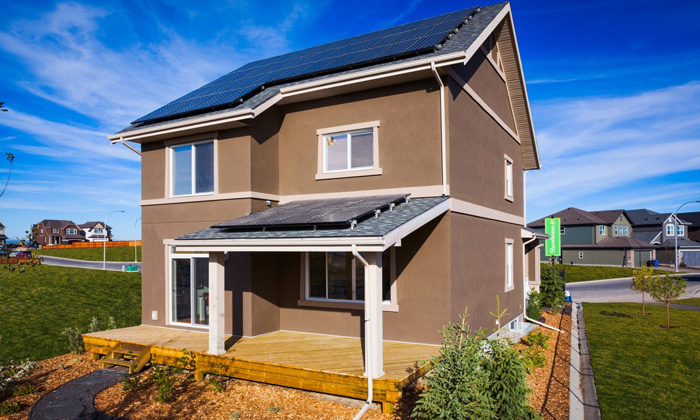Rethinking Lifestyle
Towards a Net Zero Energy Home – Part 5: Are We There Yet?

In planning our new house, my aim was to make economically and environmentally prudent choices. I had no ambition of achieving a net zero energy home. However, as time went on, I realized that the notion of net zero energy provided a useful milestone to measure progress against.
In previous articles, I described several energy conservation and production features that we included in our new house. They are listed below, showing also the amounts of energy saved or produced, in kWh per year, and the percentage of projected total typical house use (27,700 kWh/year) for each:
- Triple pane windows with argon: 793 kWh/yr (3% of total house consumption)
- Additional ceiling insulation: 462 kWh/yr (2%)
- Advanced HRV, air source heat pump: 5346 kWh/yr (19%)
- Solar PV system: 8000 kWh/yr (29%)
Total of above: 14,600 kWh/yr (53%)
- The triple pane windows and additional ceiling insulation, both showing quite positive returns on investment (described in earlier articles), had a small effect on total energy consumption.
- One feature that we did not implement was adding Styrofoam insulation to the exterior walls, because our contractor’s pricing gave it a low rate of return. Another contractor or another situation such as a DIY renovation would likely result in a lower installation cost and therefore a higher rate of return. If installed, this feature would have provided a somewhat higher total energy savings (6%) than either windows or ceiling insulation.
- The air source heat pump had both a high return on investment and a significant (projected) amount of energy savings at 19%.
- The solar PV system had a reasonable return on investment and a high (demonstrated) amount of energy production at 29%.
- According to these numbers, we will be 53% of the way to Net Zero, once the air source heat pump is fully functional.
- The solar PV system has a direct reading of energy output. The other items have projected energy savings with no direct measurement. Once all installed equipment is working properly, their combined effect will be noticeable on our electrical meter, but only as a bundle, not individually.
Are all energy savings additive? In other words, do savings by one feature affect the savings in another? I think that they are additive (do not affect each other), since heat loss is directly related to delta T, the temperature difference between the interior of the house and the outside, which is not affected by the operation of any other feature.
The air source heat pump was an important choice, but it has not been a success so far. I have discussed the problems briefly in a previous article, Part 4. Here is a further explanation. Our choice of building lot determined the choice of our general contractor and thereby the HVAC retailer/contractor. As I see it, our general contractor regularly builds simple, economical no-frills homes. He is very good at this. For example, the air tightness rating on our house is 0.88 air changes per hour, based on leakage tests, compared to 2.1 for a typical new home (the lower the number the better). The electrician and other trades people are also fully competent in the construction of these homes,. This includes air conditioning, but not air source heat pump. The electrician refused to hook up the air source heat pump, since he did not have the training to do so. The HVAC retailer/contractor made no similar declaration, but has not yet properly installed and set up the air source heat pump.
Now, after several years’ experience in our new house, I have several observations:
- Improved insulation (ceiling, windows, walls) has the advantage of being a one-time installation, with an expected long life without further attention. It has a good rate of return, but the overall effect in energy savings is small.
- The air source heat pump is projected to have an excellent return on investment and a significant overall energy saving. However, installation and maintenance are not simple, requiring properly trained technicians.
- The solar PV array has a good return on investment especially with contributions from government rebate/grant programs. Energy production is substantial. The solar panels are simple to install and are expected to have a long low maintenance life. When on-grid, the economic benefits are affected by the buy-back rate of the utility. The price of solar panels is expected to continue to decline.
- In all cases, return on investment are expected to be larger than initially projected as energy prices increase.
- I calculate that we will be 53% of the way to Net Zero, once the air source heat pump is fully functional. This number will vary with other situations and conditions.




